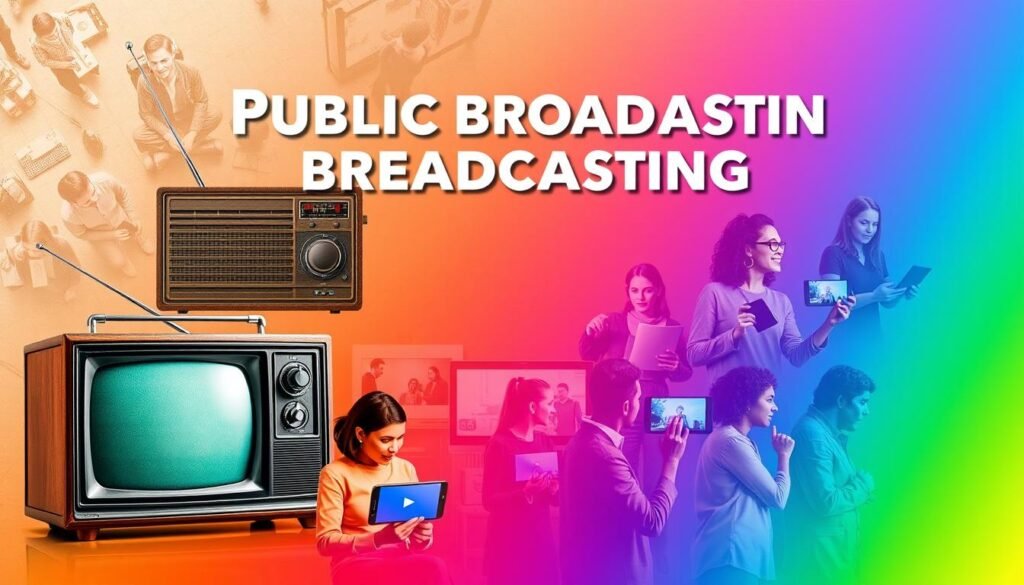Public broadcasting in the U.S. started small, at schools and universities. Now, it reaches millions with news, information, and entertainment. Its history is filled with key moments, from early radio to today’s streaming.
The Public Broadcasting Act was a big step. It helped public media grow. This article looks at how public media has changed, from radio to streaming.
Key Takeaways : Public Broadcasting
- Public broadcasting in the U.S. has evolved from local and regional radio stations to a nationally recognized source of news, information, and entertainment.
- The history of public broadcasting traces its growth from the earliest radio broadcasts to the current streaming era.
- Landmark events like the Public Broadcasting Act have shaped the development of public media over time.
- Public broadcasting has adapted and expanded to serve American audiences across multiple platforms, from radio to television and streaming.
- The evolution of public broadcasting reflects its ongoing role in providing informative, educational, and diverse content to the American public.
The Birth of Public Broadcasting: The Radio Age
The story of public broadcasting in the United States starts with the work of Guglielmo Marconi and Nikola Tesla. They experimented with wireless communication in the late 19th and early 20th centuries. Their work helped start radio broadcasting.
The Pioneering Efforts of Early Inventors
Marconi, an Italian inventor, is known for his long-distance radio system in the 1890s. His work led to radio becoming a commercial technology. Meanwhile, Nikola Tesla, a Serbian-American inventor, also played a big role in radio. He invented the Tesla coil, which was key for radio signals.
The First Scheduled Radio Broadcasts
In 1920, station KDKA in Pittsburgh, Pennsylvania, broadcast the U.S. presidential election results. This was the first scheduled radio broadcast. It started a new era in mass communication. Radio soon included news, music, and dramas that drew in listeners all over the country.
| Year | Event |
|---|---|
| 1920 | KDKA in Pittsburgh broadcasts the U.S. presidential election results, the first scheduled radio broadcast. |
| 1930s | Radio programming expands to include news, music, and serialized dramas, captivating audiences nationwide. |
| 1960s | Stereophonic broadcasting helps radio maintain its popularity amidst the rise of television. |
The early days of public radio set the stage for public broadcasting’s growth in the U.S. It paved the way for radio’s lasting impact in the future.
The Golden Era of Public Broadcasting

The 1920s and 1930s were known as the “Golden Age of Radio.” It was a time when radio became a big deal in culture. Shows like “The Lone Ranger” and “The Shadow” were hits, and news kept everyone updated.
Public broadcasting was key, especially during wartime. Journalists like Edward R. Murrow reported from the frontlines. They brought news and entertainment to the nation. By 1947, 82 out of 100 Americans listened to the radio.
Radio’s Ascendancy as a Cultural Phenomenon
Radio ownership in American homes grew fast. In 1930, 40% of homes had a radio. But by 1940, that number jumped to 83%. Networks like NBC, CBS, and Mutual Broadcasting System offered a wide range of shows.
The Role of Public Broadcasting During Wartime
During World War II, public broadcasting was crucial. Journalists like Edward R. Murrow gave updates from the frontlines. They kept the public informed and boosted morale. Radio connected the home front to the war effort.
“The news is only the first rough draft of history.”
– Edward R. Murrow
Public Broadcasting Embraces Television

Television became popular in the 1930s and grew even more after World War II. Public television used this new medium to reach more people. Shows like “Sesame Street” and “Frontline” became symbols of public broadcasting, offering something different from commercial television.
In the United States, there are 170 licensees running over 350 public TV stations. These stations cover more than 98 percent of the country. Half of these are non-profit, while the others are run by states, universities, and schools.
The National Association of Educational Broadcasters (NAEB) started in 1934. It helped grow public broadcasting. The Public Broadcasting Act of 1967 created the Corporation for Public Broadcasting (CPB) to support non-commercial TV. PBS began in 1970, taking over from NET. National Public Radio (NPR) was also founded in 1970, becoming a key source for news and education.
Public broadcasting gets money from the government, companies, and people. NPR is known for its deep reporting and educational shows. It helps share many views, making America more informed.
The loss of local news has led to “news deserts.” This shows the need for local journalism support. The Act requires CPB to spend 75% of its money on TV, even though platforms are changing. This makes it important to rethink how money is used. Grants could be linked to local content to help local areas.
The Expansion of Public Broadcasting

In the latter half of the 20th century, public broadcasting grew beyond radio and early TV. Cable and satellite TV in the 1980s and 1990s opened new doors. This allowed public broadcasters to reach more people and offer unique shows.
Organizations like PBS and NPR grew during this time. They used these new platforms to share a wide range of content. This included deep news stories and special arts and cultural shows.
Cable, Satellite, and Niche Programming
The rise of cable television and satellite television changed public broadcasting. Public broadcasters could now reach more people. They could also create niche programming for specific interests.
PBS and NPR became more important during this time. They used new tech to make innovative content. They became trusted news sources and cultural and educational leaders.
“Public television viewers are better informed, more likely to vote, have more realistic perceptions of society, and hold less negative attitudes toward immigrants.”
As media kept changing, public broadcasters kept up. They used digital platforms and streaming to stay relevant. This ensured their shows were still accessible and interesting in the 21st century.
This growth in public broadcasting enriched our culture and information. It showed the lasting value of public media in a fast-changing world. Public broadcasters continue to educate, engage communities, and preserve cultural heritage. They are key parts of the American media scene broadcasting groups d.c entire state.
Also Read : Experience Scotts Broadcast Spreader – A Landscaper’s Best Friend
Conclusion: Public Broadcasting in the Digital Streaming Era
Public broadcasting is changing with the digital age in the United States. Streaming services and on-demand content have changed how we watch media. Public broadcasters are using these platforms to reach more people and find new ways to connect with audiences.
Looking ahead, public broadcasting will use new tech like virtual reality and artificial intelligence. It will keep its main goal of informing and enriching Americans. The Public Broadcasting Act of 1967 is about to celebrate 50 years, and public media is thinking about its future.
With younger viewers preferring digital, public broadcasters need new ways to make money and engage with people. By using digital broadcasting and streaming, public media can stay important. It can offer quality content that stands out from commercial TV.
FAQs
Q: What is public media and how has it evolved over time?
A: Public media refers to media outlets that are primarily funded by the public, through mechanisms such as donations and government funding. It has evolved from traditional public radio stations and public television stations to include streaming services and digital content, allowing for broader access and engagement.
Q: How do public radio stations differ from private radio stations?
A: Public radio stations are funded by listener donations and government support, focusing on educational and informative content, while private radio stations rely on commercial advertising and often prioritize entertainment to maximize profits.
Q: What role does public radio international play in the landscape of public media?
A: Public Radio International is a key player in the public media landscape, distributing programs that emphasize public affairs, cultural content, and documentaries, thus providing a platform for diverse voices and stories.
Q: Can you explain the significance of community radio in public broadcasting?
A: Community radio serves local audiences by addressing specific regional issues and interests, fostering community engagement and participation in public media, and ensuring diverse voices are heard alongside larger broadcasting networks.
Q: How is funding for public broadcasting typically secured?
A: Funding for public broadcasting often comes from a combination of government grants, viewer and listener donations, corporate sponsorships, and sometimes partnerships with educational institutions, which help sustain operations without relying heavily on commercial advertising.
Q: What types of programming can listeners expect from public radio and television stations?
A: Listeners can expect a wide range of programming from public radio and television stations, including news and public affairs shows, educational TV programs, documentaries, cultural programming, and unique radio programs that may not be available on commercial networks.
Q: How have technological advancements impacted public service media?
A: Technological advancements have significantly impacted public service media by enabling streaming services, podcasting, and on-demand content, allowing audiences to access public radio and television anywhere and anytime, thus broadening their reach and engagement.
Q: What are some examples of public television networks in the U.S.?
A: Examples of public television networks in the U.S. include PBS (Public Broadcasting Service), which provides a wide array of educational and entertaining programs, and various regional public television stations that cater to local interests and communities.
Q: What is the role of the public radio satellite system in broadcasting?
A: The Public Radio Satellite System facilitates the distribution of programs to public radio stations across the country, ensuring that even remote stations can access high-quality content and broadcast it to their audiences.
Q: How do documentaries produced by public media differ from those created by commercial networks?
A: Documentaries produced by public media often focus on educational content and social issues, prioritizing in-depth storytelling and informative narratives over sensationalism, which is more common in commercial network productions aimed at maximizing viewership.


